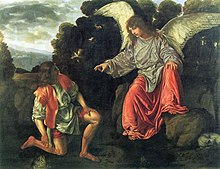
Tobias and the Angel is the traditional title of depictions in art of a passage from the Book of Tobit in which Tobias, son of Tobit, travels with the Archangel Raphael without realising he is an angel (5.5–6) and is then instructed by Raphael what to do with a giant fish he catches (6.2–9). The Book of Tobit is accepted by Catholic and Eastern Orthodox Christians as part of the biblical canon, but not by Judaism or most Protestant Christians, the latter including it in the Apocrypha.[1]
Depictions usually show Raphael and a much smaller Tobias walking through a landscape, accompanied by Tobias's dog.[2] Tobias is usually carrying a fish (or two), often tied up with string, or a container for the fish's organs that will later cure his father; more often Raphael carries a small box with these.[3] Raphael usually has large wings, which we must suppose are invisible to Tobias, as in the story he remains unaware his companion is an angel. When the story was written, angels were not imagined to have wings, which were a later convention, taken from the Roman winged Victory.[4]

An alternative depiction, somewhat less common until the Baroque period in the 17th century, shows Tobias with the very large fish he catches in the River Tigris. Typically Tobias is on the ground, sometimes in the water, and Raphael stands behind him, encouraging him to catch it. The fish Tobias carries in the travelling depictions are much more normally sized, and like the dog and Raphael's wings, serve as attributes to identify the subject. Where the composition allows it, both scenes may be shown.[5] It is thought that the original story (which survives in Hebrew, Aramaic and Greek versions) probably involved a crocodile rather than a fish.[6]
Dogs are unusual in Christian religious art,[7] but the New Testament subject of the Exorcism of the Syrophoenician woman's daughter and the Old Testament one of Tobias and the Angel are exceptions, as they are mentioned in the texts, and depictions often include them. Although the dog in the Biblical account is presumably given to Tobias by his father to provide security as he travels carrying a significant amount of silver, artists tend to show very small dogs, with a long coat of hair that covers deficiencies in drawing them. Artists become noticeably more competent in this as the Renaissance progresses. Ancient Israelites regarded dogs as unclean, and they are "seldom represented elsewhere in the Bible as man's friend", another element suggesting the origin of the story in neighbouring cultures.[8]
